Cucumbers are one of the most popular vegetables on the planet. They can be used in several ways, from salads and soups to pickles and spa treatments.
While we often see medium-sized, green, smooth-skinned ones, there are at least 100 species of cucumbers grown worldwide.
This blog post will uncover the health benefits of cucumbers and eleven unusual varieties of cucumbers you may not be familiar with. From the snake cucumber to the Korean cucumber, these varieties offer unique flavors and textures that are definitely worth a try.
If you’re looking for something new to add to your kitchen menu, keep reading!
Table of Contents
Cucumber: The Basics
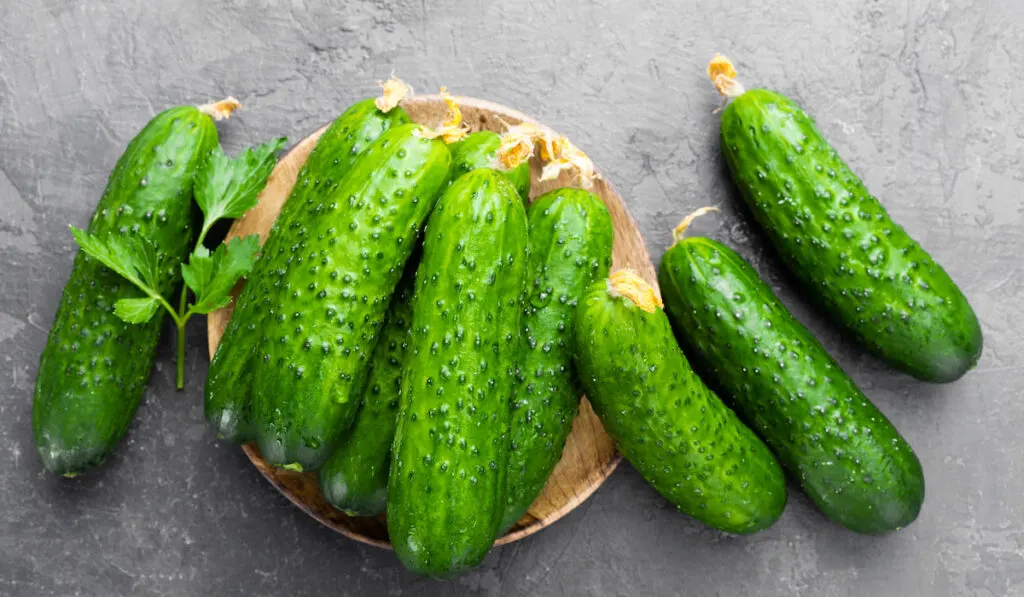
Cucumbers are creeping vegetables cultivated mainly for culinary purposes.
They are often cylindrical, with an average length of 6-8 inches. Their colors range from the common green to red, white, yellow, and even orange.
The scientific classification is as follows:
| Kingdom | Plantae |
| Division | Magnoliophyta |
| Class | Magnoliopsida |
| Order | Cucurbitales |
| Family | Cucurbitaceae |
| Genus | Cucumis |
| Species | sativus |
Cucumbers comprise six (6) main groups:
● Slicing cucumbers
● Pickling cucumbers
● Burpless or seedless cucumbers
● Specialty cucumbers
● Greenhouse Cucumbers
● Container cucumbers
Slicing Cucumbers

Slicers, as they are commonly called, are naturally edible cucumbers. They are typically green and have thin, mildly sweet skin.
Slicing cucumbers can grow up to twelve inches long but are best harvested at the recommended market size. This is because the skin can grow thick and bitter as it develops. The seeds can also grow larger, making it less enjoyable to eat the flesh.
Pickling Cucumbers
Pickling cucumbers are a shorter variety, growing up to six inches long. They have thicker, drier skin that helps them soak up brine during pickling.
Burpless or Seedless Cucumbers

Burpless or seedless cucumbers are exactly what they sound like – cucumbers without seeds. They’re ideal for slicing or chopping into salads.
Burpless cucumbers do not contain cucurbitacin, the compound responsible for the bitter taste in cucumbers and gas buildup in the stomach.
Specialty Cucumbers
Specialty cucumbers are heirloom cucumbers grown for flavor, color, and other desirable traits.
Greenhouse Cucumbers
Greenhouse cucumbers are self-pollinators and do not require any agents for their pollination.
Container Cucumbers
Container cucumbers have a smaller space requirement that makes them perfect for growing in containers. They are ideal for decks, balconies, or small gardens.
Health Benefits of Cucumbers
Besides their great taste and cooling effect, cucumbers offer a variety of health benefits. These benefits include the following:
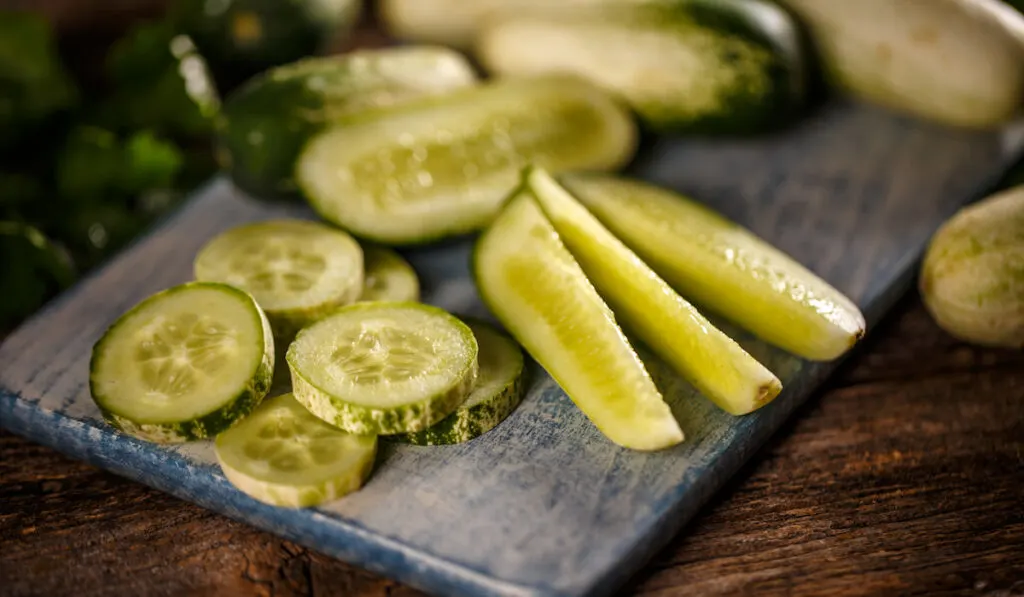
Hydration
Cucumbers have an average water content of 96%. This high water level makes them a great source of hydration.
Vitamins and Minerals
Cucumbers are rich in vitamins A, C, K, and E. They also supply potassium, phosphorus, magnesium, and zinc.
This rich supply of vitamins and minerals makes cucumbers a cheap source of essential body nutrients.
Digestion
Cucumbers contain fiber, which facilitates proper digestion and bowel movements. Their high water content also improves digestion and prevents constipation.
Antioxidants
Cucumbers are rich in antioxidants, which can help prevent cellular damage and degenerative diseases.
Anti-Inflammatory
Cucumbers can help reduce inflammation. This trait makes them useful for treating gout and joint pain.
11 Unusual Cucumber Varieties
Cucumbers come in all shapes and sizes, but some cucumber varieties are truly unusual. Here are eleven such varieties:
1. Snake Cucumber

The snake cucumber, widely known as the Armenian cucumber, gets its name from its long, curved, snake-like shape.
A snake cucumber is actually a muskmelon, but similar to a cucumber in taste and appearance.
Snake cucumbers are usually about a foot long and have thin skin that’s easy to peel. They’re rich in zinc and potassium and contain vitamins C and K.
2. Lemon Cucumber
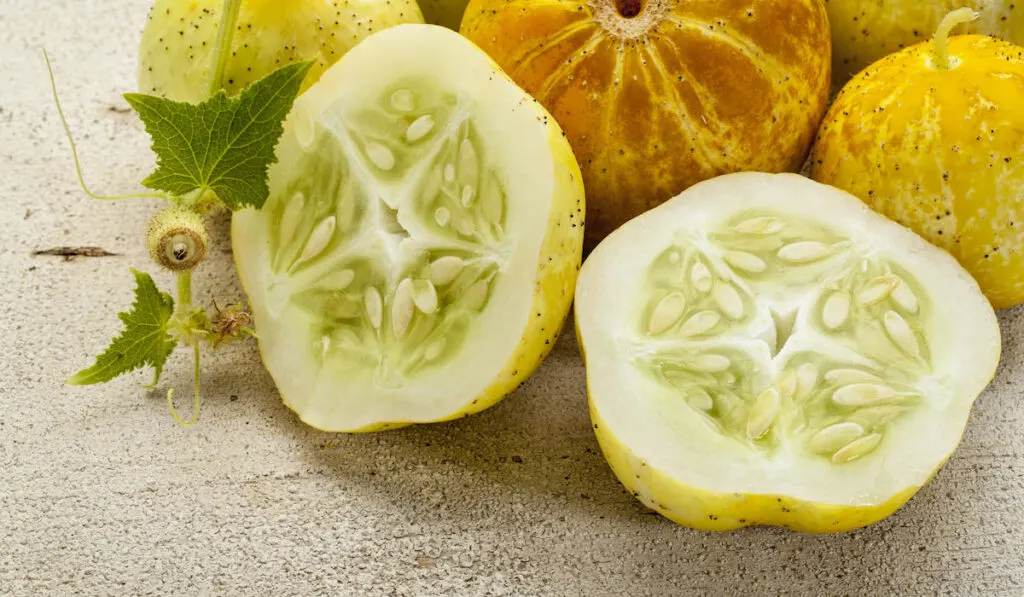
Lemon cucumbers are small, ball-shaped cucumbers, round like lemons. This variety is usually yellow and covered in tiny black spikes.
A lemon cucumber has a tart, tangy flavor that adds a unique taste when used as a garnish for salads and other dishes.
Lemon cucumbers are also rich in antioxidants, as well as vitamins C and K, calcium, potassium, and fiber.
3. ‘White Wonder’ Cucumber

‘White Wonder’ cucumbers are cylindrical and primarily white.
Each cucumber has an average length of 7 inches. The thin, tough skin changes from the characteristic white to cream as the cucumber ages.
The ‘White Wonder’ also has a central seed cavity and a crunchy, juicy feel when chewed.
‘White Wonder’ cucumbers are a rich source of B vitamins, vitamins C and K, magnesium, manganese, copper, fiber, and antioxidants.
4. ‘Salt and Pepper’ Cucumber
This cucumber variety has thin white skin and black spines, similar to the lemon cucumber. This white skin progressively turns yellow as the cucumber develops.
‘Salt and Pepper’ cucumbers have a unique, sweet taste and crunchy texture and are rich in vitamins C and K.
5. ‘Martini’ Cucumber
The ‘Martini’ cucumber is a pale white, non-yellowing variety of cucumber. It has a bumpy, slightly spiked yet tender skin.
‘Martini’ cucumbers can grow up to 9 inches but are best harvested at 5-6 inches. They have a crunchy texture and sweet taste that makes them enjoyable even when eaten raw.
‘Martini’ cucumbers are also a cheap source of vitamins C, K, and potassium.
6. ‘Suyo Long’ Cucumber
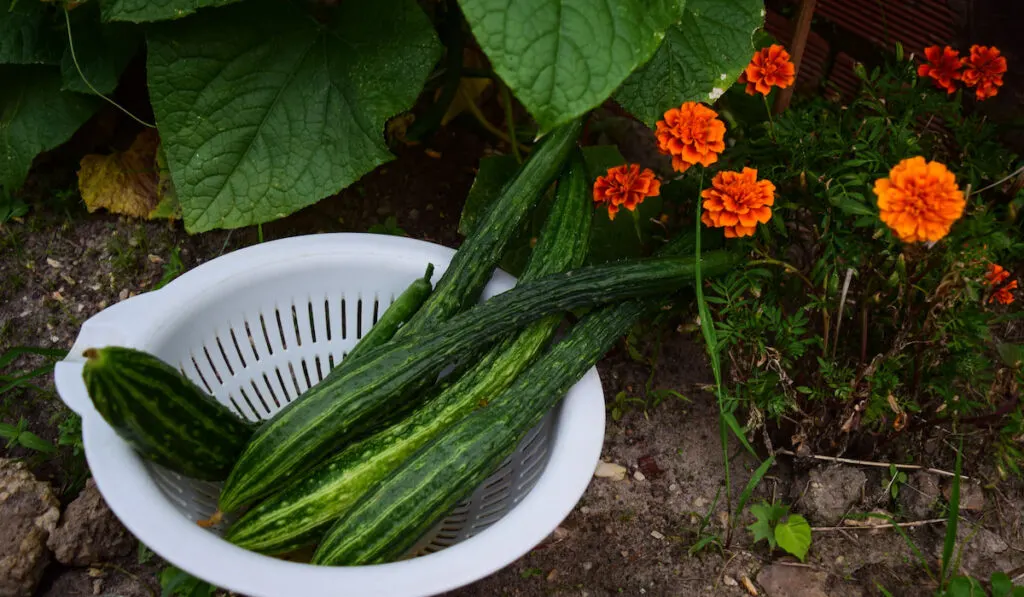
The ‘Suyo Long’ cucumber is long and skinny, with soft spikes scattered across its thin, dark green skin.
This variety often grows into different shapes, reaching lengths of eighteen inches.
A ‘Suyo Long’ cucumber is crisp, crunchy, and has little to no bitterness.
‘Suyo Long’ cucumbers are a good source of vitamins A, B, and C, as well as calcium, magnesium, potassium, phosphorus, and zinc.
7. ‘Barattiere’ Cucumber
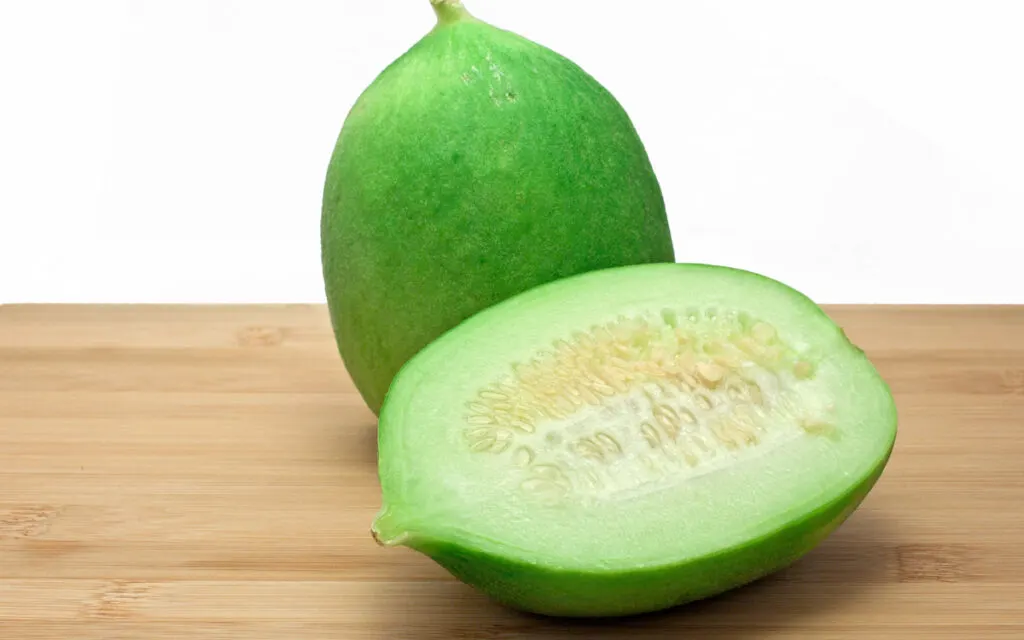
The ‘Barattiere’ is a round, often ball-shaped cucumber. These cucumbers progressively change from dark green to lighter shades of green to yellow as they mature.
The skin is often smooth but bumpy, and the flesh is primarily ivory.
‘Barattiere’ cucumbers are rich in vitamin C, potassium, phosphorus, copper, and zinc.
8. ‘Marinda’ Cucumber
The ‘Marinda’ cucumber is a long, cylindrical-shaped cucumber with rounded ends. It has dark green, semi-thick skin that is covered in tiny bumps. It also has a central seed cavity filled with thin, ivory seeds.
A ‘Marinda’ cucumber is mildly sweet, having no bitter taste, as is common with some cucumbers.
‘Marinda’ cucumbers are a great source of dietary fiber, vitamins A, C, and K, manganese, magnesium, and potassium.
9. Caigua
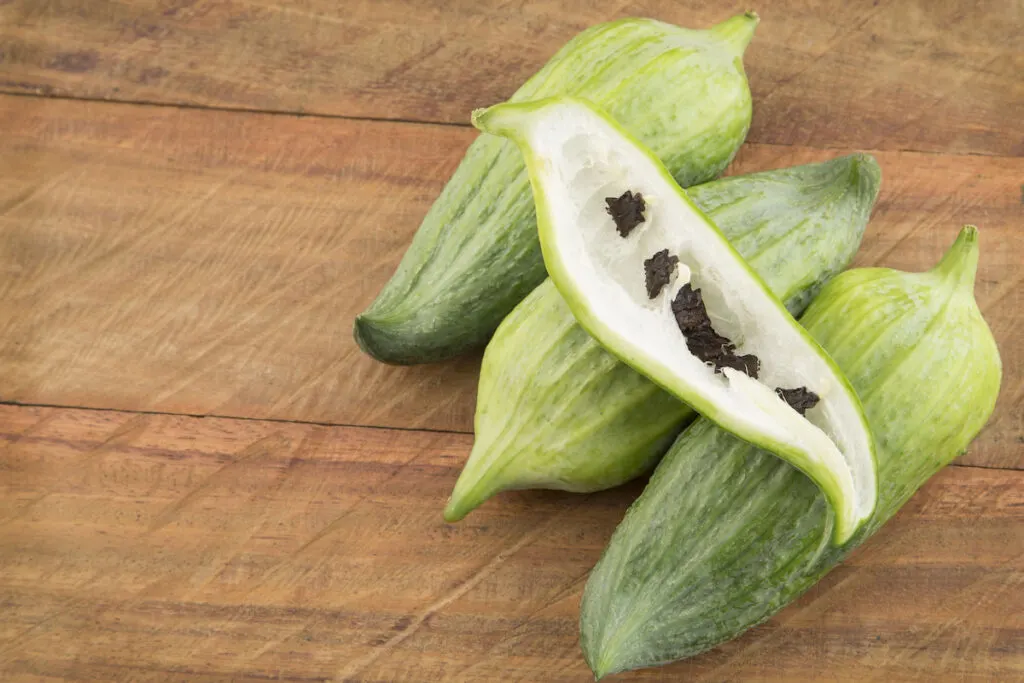
Caigua, the wild cucumber, is a unique cucumber variety: it’s shaped like a teardrop.
A caigua cucumber progressively goes from dark green to pale green and then yellowish-green as it ripens. The thick skin can be smooth or spiked, encasing pale green, spongy flesh and edible seeds.
With time, these seeds become black, inedible, arrow-shaped kernels, and the flesh becomes cotton-like.
Caigua cucumbers are a great source of essential body nutrients, including zinc, phosphorus, vitamin C, potassium, magnesium, and calcium.
10. Malabar Cucumber
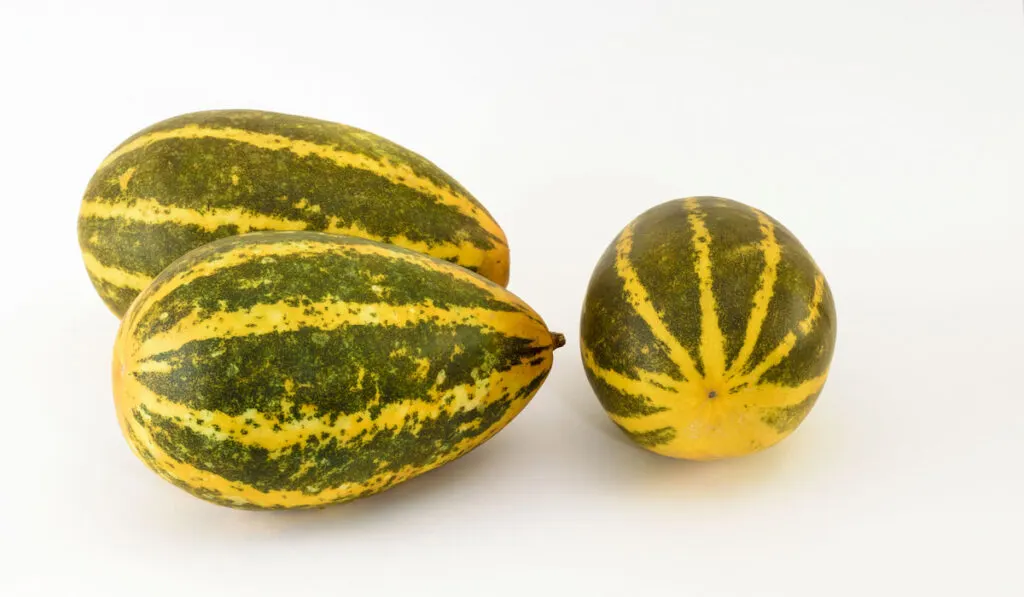
The Malabar cucumber is an elongated, cylindrical-shaped cucumber. Its color progressively changes from dark green with light green stripes to orange with golden-yellow stripes as it matures.
A Malabar cucumber has a central seed cavity containing seeds that are often bitter. It has a unique, mildly sweet taste and a crunchy feel when eaten raw.
Malabar cucumbers are rich in essential vitamins (A, C, and E) minerals (potassium, magnesium and phosphorus), and antioxidants.
11. Korean Cucumber

Korean cucumbers are long, cylindrical, and slender. They have firm, light green or dark green, striated, or mottled skin covered in small, soft pines.
They have tiny, edible, cream-colored seeds suspended in the center.
When eaten raw, Korean cucumbers taste sweet and feel crunchy.
Korean cucumbers are a great source of vitamins A and C, iron, and potassium.
Summary
With so many cucumber varieties out there, it can be hard to know which ones to choose. We hope our list of eleven unusual cucumber varieties helps you figure out which cucumbers to try.
Whether you’re looking for a new pickling cucumber or a sweet snacking cucumber, we’re confident you’ll find it on this list.
Resources
- https://specialtyproduce.com
- https://gardenerspath.com/plants/vegetables/top-cucumber-varieties
- https://www.gardeningchores.com/types-of-cucumbers
- https://www.healthline.com/nutrition/7-health-benefits-of-cucumber
- https://www.medicalnewstoday.com/articles/283006#benefits-
- https://specialtyproduce.com/produce/Barattiere_Cucumbers_22733.php
- https://www.panamseed.com/plant_info.aspx?phid=020400001010130
